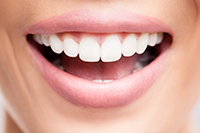
Teeth Whitening Bleaching or "whitening" your teeth is one of, if not, the most popular treatments in cosmetic dentistry. The treatment is a quick, accessible, affordable, and non-invasive way to enhance the appearance of your smile. By definition of the FDA, any product that is used to clean the teeth is considered a whitener. With this in mind, when we talk about teeth whitening, it usually refers to bleaching the teeth. Bleaches used in teeth whitening are usually non-chlorine bleaches like carbamide peroxide or hydrogen peroxide. Teeth whitening can remove stains from teeth however, teeth whitening is not permanent. Effects can be long-lasting if done in conjunction with habit and lifestyle changes. Bleaching or "whitening" your teeth is one of, if not, the most popular treatments in cosmetic dentistry. The treatment is a quick, accessible, affordable, and non-invasive way to enhance the appearance of your smile. By definition of the FDA, any product that is used to clean the teeth is considered a whitener. With this in mind, when we talk about teeth whitening, it usually refers to bleaching the teeth. Bleaches used in teeth whitening are usually non-chlorine bleaches like carbamide peroxide or hydrogen peroxide. Teeth whitening can remove stains from teeth however, teeth whitening is not permanent. Effects can be long-lasting if done in conjunction with habit and lifestyle changes.  At-Home Bleaching TreatmentsBleach concentrations range from 10 - 16% percent. A more common bleach for at-home teeth whitening is carbamide peroxide. The bleach is slower acting and eventually breaks down into hydrogen peroxide. Carbamide peroxide is about 30 percent as effective as hydrogen peroxide. Whichever you choose, your teeth may need multiple treatments to restore their color. Teeth Enamel And DentinYour teeth are protected with a porcelain-like translucent tissue called enamel. Enamel is the hardest tissue in the human body, harder than bone. Enamel is composed of microscopic crystalline rods, which protects the teeth from repeated chewing, gnashing, trauma, bacteria, and wear from sugars and acids. Dentin is the second layer and main body of the tooth. It's inherently yellow, and some people have a greenish-gray shade of dentin. With age and regular wear, millions of microscopic cracks form in the enamel. These cracks and the spaces between the rods, fill up with stains and food debris. The teeth will develop a dull appearance. As we age the dentin becomes more visible behind the enamel. External And Internal Teeth StainingThere are two types of tooth stains: extrinsic and intrinsic. Extrinsic stains form on the enamel. They are easily removed with good oral hygiene and regular dental cleanings. Intrinsic stains form on the inside of the tooth. They can be caused by craniofacial trauma, exposure to minerals during teeth development, and over ingestion of fluoride. In the past, intrinsic stains were difficult to remove with available bleaching treatments. Cosmetic dentistry treatments have since improved, and deep-set intrinsic stains can be removed with at-home whitening kits. Genetic traits can affect people's teeth color and response to teeth whitening. Smoking, certain drugs, or chemicals can greatly affect teeth color. Habitual consumption of darkly colored foods can stain the teeth over time, so it is important to maintain good oral hygiene between meals. After Effects Of Teeth BleachingOver 50 percent of people who have received a peroxide treatment have reported some level of gum irritation. This can last up to several days. High concentration bleaches can temporarily increase tooth sensitivity. People with gum recession have a higher risk of experiencing tooth sensitivity. Composite resin bondings are not affected by bleaching, any discoloration will remain while the surrounding teeth are whitened. If you are considering a bleaching treatment to brighten your smile, consult one of our dentists at Masci, Hale & Wilson Advanced Aesthetic and Restorative Dentistry, they can go over your past medical history, current oral health, and lifestyle habits to recommend the best plan for treatment and maintaining its results. Call us at (845) 457-5763 to schedule a consultation, or for more information. |
HoursMon - Fri: 7:30am - 5:00pm Closed Saturday & Sunday |